
I am a strong believer in concepts and principles.
I firmly believe that before we learn to use tools, it’s critical to have a strong conceptual understanding.
This understanding allows us to put the tools to the best possible use, regardless of the type of tools involved.
Let’s consider data analytics as an example.
We have a lot of tools to carry out analysis.
The foundational purposes of analytics can be classified into four types.
Simply understanding these four basic purposes will help us realize the context behind why we engage in analysis.
However, you don’t need to be a statistics whiz or an analytics guru to accomplish this.
By grasping the basics, you can hit the ground running and collaborate effectively with your analytics team.
So, let’s roll up our sleeves and dive into the four types of analytics that every one of us should be familiar with.
1. Descriptive analytics
First up, we have descriptive analytics, which is like a historian who looks at the past to describe what has happened.
It helps answer questions like “what happened,” “how did it happen,” and “why did it happen.”
For example, a retail store might use descriptive analytics to analyze their sales patterns over the past year to plan their inventory and promotions for the upcoming year.
2. Predictive analytics
Next, we have predictive analytics, which is like a weather forecaster who uses past data to predict future outcomes.
It helps answer questions like – “what will happen,” “how will it happen,” and “why will it happen.”
For instance, a manufacturing company might use predictive analytics to predict future demand for their products based on past sales data and customer behavior.
3. Prescriptive analytics
Then there’s prescriptive analytics, which is like a doctor who uses data and analysis to recommend a course of action.
It helps answer questions like – “what should be done,” “how should it be done,” and “why should it be done.”
For example, a logistics company might use prescriptive analytics to optimize their delivery routes and reduce costs by analyzing data on delivery times, traffic patterns, and fuel costs.
4. Diagnostic analytics
Finally, we have diagnostic analytics, which is like a detective who uses data and analysis to identify the root cause of a problem.
It helps answer questions like “what is the problem,” “how did it happen,” and “why did it happen.”
A restaurant, for instance, might use diagnostic analytics to analyze customer reviews, menu items, and staff performance to understand why their sales have been decreasing and take corrective actions accordingly.
So, there you have it!
Imagine donning the hats of a historian, weather forecaster, doctor, and detective to enhance decision-making and solve problems more effectively using analytics.
These roles represent distinct mental models in your toolbox, and you can employ them based on the situation at hand.
The next time you collaborate with an analytics team or encounter a problem, consider which type of analytics could prove most valuable, and ask the appropriate questions.
You’ll be surprised by how much you can accomplish!




